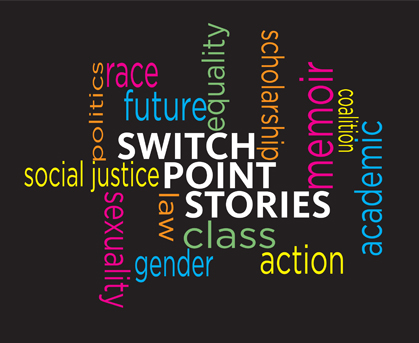Event Title
Panel 2: Intersections of Sex, Race, Gender & Juvenile Justice
Location
Krongard Room
Start Date
29-3-2013 11:15 AM
End Date
29-3-2013 12:30 PM
Description
Mine is a story about how story leads to theory—theories I’ve been sharing at pediatrics conferences with practicing doctors and at meetings with statewide social workers working with youth. Surprisingly, I’m learning that practitioners are hungry for conceptual resources, thoughts that stretch the boundaries, sometimes break the boundaries, of “common sense” approaches to identity categories. In these presentations, which I seek to make accessible, three specific theories are my tender destination. Time permitting on our panel, I’ll briefly touch on each of them.
THEORY #1 is the theory of the switchpoint, which is an asymmetrical crossing between two signs: often in my research between the signs “black” and “queer.” I’m going to tell the story of my “gay” childhood by crossing it through a rarely-if-ever-seen “black” childhood, which is how I came to craft the theory of the switchpoint.
THEORY #2 involves the “gay” child arising from my story as a dramatization of the queer childhoods of all of us here, whoever we are, for we are “queer” (feel free to disagree….).
Which leads, finally, to THEORY #3, where I’ll begin. Sexual sameness does not exist. You are queer because we’re not the same, because we’re all “hetero,” because there’s no such thing as homo-sexuality.
These three theories allow me to explain how the “gay” child has not been in History; how it has a backwards birth; how it is not, in any direct sense, a bio-category but a profound connection to a word or set of words that are enfleshed. What might the notion of a “gay” child do to conceptions of the child? Kid Orientalism, to put the matter cryptically, is one of its results.
Media Format
youtube
Media Format
flash_audio
Full Text of Presentation
wf_yes
Panel 2: Intersections of Sex, Race, Gender & Juvenile Justice
Krongard Room
Mine is a story about how story leads to theory—theories I’ve been sharing at pediatrics conferences with practicing doctors and at meetings with statewide social workers working with youth. Surprisingly, I’m learning that practitioners are hungry for conceptual resources, thoughts that stretch the boundaries, sometimes break the boundaries, of “common sense” approaches to identity categories. In these presentations, which I seek to make accessible, three specific theories are my tender destination. Time permitting on our panel, I’ll briefly touch on each of them.
THEORY #1 is the theory of the switchpoint, which is an asymmetrical crossing between two signs: often in my research between the signs “black” and “queer.” I’m going to tell the story of my “gay” childhood by crossing it through a rarely-if-ever-seen “black” childhood, which is how I came to craft the theory of the switchpoint.
THEORY #2 involves the “gay” child arising from my story as a dramatization of the queer childhoods of all of us here, whoever we are, for we are “queer” (feel free to disagree….).
Which leads, finally, to THEORY #3, where I’ll begin. Sexual sameness does not exist. You are queer because we’re not the same, because we’re all “hetero,” because there’s no such thing as homo-sexuality.
These three theories allow me to explain how the “gay” child has not been in History; how it has a backwards birth; how it is not, in any direct sense, a bio-category but a profound connection to a word or set of words that are enfleshed. What might the notion of a “gay” child do to conceptions of the child? Kid Orientalism, to put the matter cryptically, is one of its results.
